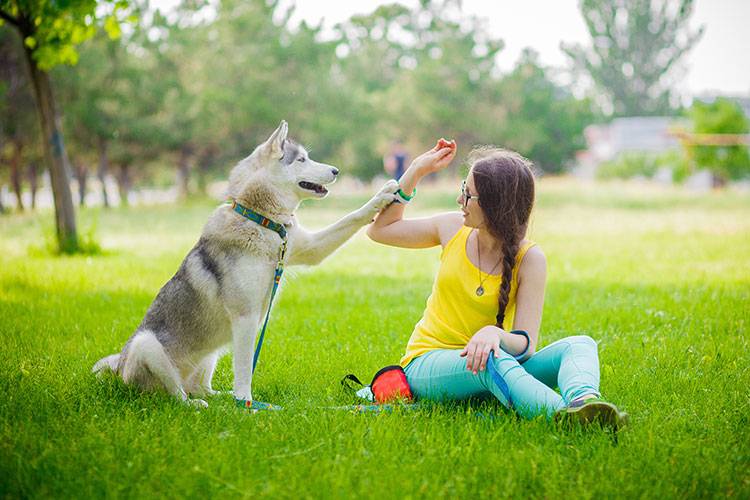Pawing and scratching might seem like innocent or even endearing behaviors in dogs, but they can quickly turn into a problem behavior—especially when you’re dealing with a large breed or a small dog living with young children. While many dog owners tolerate the occasional paw to the leg, repeated pawing often signals a deeper issue that needs to be addressed.
This dogs paw behavior can stem from a need for attention, a lack of mental stimulation, or simply a misunderstanding of what’s acceptable behavior. Thankfully, with consistency and a bit of insight into dog behavior, pet parents can guide their furry friend toward calm behavior instead.
Why Dogs Paw or Scratch People
Dogs paw at people for a variety of reasons, but it nearly always boils down to communication. In fact, according to a 2024 study published in the Journal of Applied Animal Behavior Science, 63% of dogs who frequently use their paw are reacting to unintentional reinforcement. That is, the dog owner is unknowingly encouraging the annoying habit by responding—often with affection or treats.
Common Reasons for Pawing:
- Seeking attention
- Requesting food or treats
- Experiencing anxiety or discomfort
- Lacking mental stimulation
- Boredom or attempting to avoid negative attention
Even well-meaning patting can reinforce this unwanted behavior, especially in puppies still learning boundaries.
Don't Just Take Our Word For It
FAQs About Pawing and Scratching
Q: Is pawing a sign of aggression?
A: Not usually. It’s often a sign your furry friend wants interaction or is experiencing stress. If barking, growling, or a stiff tail accompanies the pawing, consult a behaviorist.
Q: Should I scold my dog for pawing?
A: No. Reacting with frustration may lead to negative attention, which is still attention. Instead, reward calm behavior and ignore the pawing.
Q: What if my dog paws guests?
A: Redirect the behavior. Teach your dog to sit on a mat when guests arrive. You can also redirect to chew toys or a nose “touch” command to prevent unwanted jumping or scratching.
How to Stop a Dog From Pawing and Scratching People
As a professional dog trainer, I’ve seen dogs paw at people in surprising ways. Years ago, during a home lesson, a massive Great Dane greeted me with a paw slap across the back that left scratches and bruises. That kind of bad behavior is more than an annoying habit—it’s a safety concern.
The dogs paw reflex usually begins with a reward, even if it’s unintentional. When pet parents respond with affection, food, or patting, dogs learn that using their paw gets results. Even teaching a “shake” trick can encourage dog behavior that spills into other contexts. Instead of reinforcing that motion, try teaching alternative behavior like “sit” or “down,” which can be more easily rewarded without causing issues.
Effective Ways to Curb the Behavior
When dogs paw, and it’s ignored rather than rewarded, the behavior naturally fades. Use these techniques to create lasting results:
- Wait until all four paws are on the floor.
- Reward only calm behavior—use “yes” or a clicker, then treat.
- Repeat daily until the behavior becomes consistent.
You can also teach your small dog or puppies to “touch” with their nose as a greeting instead of pawing. This keeps their mouth and paws away from guests and maintains appropriate dog body language. For dogs who continue pawing for attention, redirect them to toys or chew toys and reward when they settle.
If your dog shows signs of discomfort, such as licking their paw excessively, wagging their tail unusually, or showing tension in their dog’s body language, it could be a sign of anxiety rather than dominance. Addressing these issues early can prevent them from turning into problem behavior.
Support for Pet Parents
Breaking a dogs paw habit takes time, but understanding your dog’s motivation is key. Whether you have a golden retriever, small dog, or a lively pup, the solutions are the same: teach alternative behavior, avoid rewarding bad behavior, and consistently reinforce the good stuff.
And while you’re working on training, don’t forget the importance of pet insurance. Accidents can happen—from scratched guests to injured paws—and pet insurance helps cover those unexpected vet visits, giving you peace of mind as a responsible dog owner.
If you’re dealing with dogs paw constantly or unsure how to interpret your dog’s body language, consider speaking with a certified trainer. You’ll be better equipped to guide your furry friend toward healthier, more appropriate ways to ask for what they need.
How to Stop Dog Pawing Behavior
When behaviors are no longer rewarded, they will disappear. When a dog paws at you, take a step back and wait until all four feet touch the ground. The moment all four feet touch the ground, say “yes” and reward your dog. Of course, most dogs will paw right afterwards because they’re not sure which behavior provided the treat. Reward only when all four on the floor again.
Continue to practice daily, and wait for your dog to make a choice—watching your dog make a decision is a glorious thing to watch. Some dogs will gently place their paw on a person, think for a few seconds, then drop their paw to the ground. Reward good choices every time!
To prevent your dog from jumping up and pawing guests, teach him to “touch” guest’s hands with his nose. This keeps all four feet on the ground, gives your dog a chance to decide if he wants to greet a guest and offers a form of physical contact (like petting) for your guest.
If you don’t reward it, the behavior will disappear. 🙂




